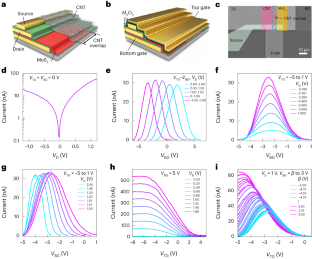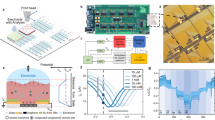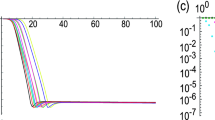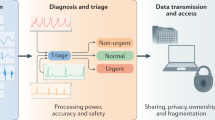Abstract
Advances in algorithms and low-power computing hardware imply that machine learning is of potential use in off-grid medical data classification and diagnosis applications such as electrocardiogram interpretation. However, although support vector machine algorithms for electrocardiogram classification show high classification accuracy, hardware implementations for edge applications are impractical due to the complexity and substantial power consumption needed for kernel optimization when using conventional complementary metal–oxide–semiconductor circuits. Here we report reconfigurable mixed-kernel transistors based on dual-gated van der Waals heterojunctions that can generate fully tunable individual and mixed Gaussian and sigmoid functions for analogue support vector machine kernel applications. We show that the heterojunction-generated kernels can be used for arrhythmia detection from electrocardiogram signals with high classification accuracy compared with standard radial basis function kernels. The reconfigurable nature of mixed-kernel heterojunction transistors also allows for personalized detection using Bayesian optimization. A single mixed-kernel heterojunction device can generate the equivalent transfer function of a complementary metal–oxide–semiconductor circuit comprising dozens of transistors and thus provides a low-power approach for support vector machine classification applications.
This is a preview of subscription content, access via your institution
Access options
Access Nature and 54 other Nature Portfolio journals
Get Nature+, our best-value online-access subscription
$29.99 / 30 days
cancel any time
Subscribe to this journal
Receive 12 digital issues and online access to articles
$119.00 per year
only $9.92 per issue
Buy this article
- Purchase on Springer Link
- Instant access to full article PDF
Prices may be subject to local taxes which are calculated during checkout




Similar content being viewed by others
Data availability
The data for all the figures in this Article are available via the Harvard Dataverse repository at https://doi.org/10.7910/DVN/0AAPVD.
Code availability
The code used in this study is available via GitHub at https://github.com/JennyMa0517/mixed-kernel-heterojunction.
References
Noble, W. S. What is a support vector machine? Nat. Biotechnol. 24, 1565–1567 (2006).
Cervantes, J., Garcia-Lamont, F., Rodríguez-Mazahua, L. & Lopez, A. A comprehensive survey on support vector machine classification: applications, challenges and trends. Neurocomputing 408, 189–215 (2020).
Genov, R. & Cauwenberghs, G. Kerneltron: support vector ‘machine’ in silicon. IEEE Trans. Neural Netw. 14, 1426–1434 (2003).
Devikanniga, D., Ramu, A. & Haldorai, A. Efficient diagnosis of liver disease using support vector machine optimized with crows search algorithm. EAI Endorsed Trans. Energy Web 7, e10 (2020).
Wang, H., Zheng, B., Yoon, S. W. & Ko, H. S. A support vector machine-based ensemble algorithm for breast cancer diagnosis. Eur. J. Oper. Res. 267, 687–699 (2018).
Ahmad, I., Basheri, M., Iqbal, M. J. & Rahim, A. Performance comparison of support vector machine, random forest, and extreme learning machine for intrusion detection. IEEE Access 6, 33789–33795 (2018).
Afifi, S. M., GholamHosseini, H. & Sinha, R. Hardware implementations of SVM on FPGA: a state-of-the-art review of current practice. Int. J. Innov. Sci. Eng. Technol. 2, 733–752 (2015).
Shoeb, A. H. & Guttag, J. V. Application of machine learning to epileptic seizure detection. In Proc. 27th International Conference on Machine Learning (ICML-10) 975–982 (PMLR, 2010).
Bin Altaf, M. A. & Yoo, J. A 1.83 µJ/classification, 8-channel, patient-specific epileptic seizure classification SoC using a non-linear support vector machine. IEEE Trans. Biomed. Circuits Syst. 10, 49–60 (2016).
Kang, K. & Shibata, T. An on-chip-trainable Gaussian-kernel analog support vector machine. IEEE Trans. Circuits Syst. I, Reg. Papers 57, 1513–1524 (2010).
Zhang, R. & Shibata, T. Fully parallel self-learning analog support vector machine employing compact Gaussian generation circuits. Jpn. J. Appl. Phys. 51, 04DE10 (2012).
Alimisis, V., Gourdouparis, M., Dimas, C. & Sotiriadis, P. P. A 0.6 V, 3.3 nW, adjustable Gaussian crcuit for tunable kernel functions. In 2021 34th SBC/SBMicro/IEEE/ACM Symposium on Integrated Circuits and Systems Design (SBCCI) 1–6 (IEEE, 2021).
Vrtaric, D., Ceperic, V. & Baric, A. Area-efficient differential Gaussian circuit for dedicated hardware implementations of Gaussian function based machine learning algorithms. Neurocomputing 118, 329–333 (2013).
Reda Mohamed, A., Qi, L., Li, Y. & Wang, G. A generic nano-watt power fully tunable 1-D Gaussian kernel circuit for artificial neural network. IEEE Trans. Circuits Syst., II, Exp. Briefs 67, 1529–1533 (2020).
Sangwan, V. K. & Hersam, M. C. Neuromorphic nanoelectronic materials. Nat. Nanotechnol. 15, 517–528 (2020).
Sangwan, V. K. et al. Self-aligned van der Waals heterojunction diodes and transistors. Nano Lett. 18, 1421–1427 (2018).
Sebastian, A., Pannone, A., Subbulakshmi Radhakrishnan, S. & Das, S. Gaussian synapses for probabilistic neural networks. Nat. Commun. 10, 4199 (2019).
Beck, M. E. et al. Spiking neurons from tunable Gaussian heterojunction transistors. Nat. Commun. 11, 1565 (2020).
Duong, D. L., Lee, S. M. & Lee, Y. H. Origin of unipolarity in carbon nanotube field effect transistors. J. Mater. Chem. 22, 1994–1997 (2012).
Wang, K.-C. et al. Atomic-level charge transport mechanism in gate-tunable anti-ambipolar van der Waals heterojunctions. Appl. Phys. Lett. 118, 083103 (2021).
Kim, C. H., Hayakawa, R. & Wakayama, Y. Fundamentals of organic anti‐ambipolar ternary inverters. Adv. Electron. Mater. 6, 1901200 (2020).
Wu, E. et al. Photoinduced doping to enable tunable and high-performance anti-ambipolar MoTe2/MoS2 heterotransistors. ACS Nano 13, 5430–5438 (2019).
Kobashi, K., Hayakawa, R., Chikyow, T. & Wakayama, Y. Multi-valued logic circuits based on organic anti-ambipolar transistors. Nano Lett. 18, 4355–4359 (2018).
Li, Y. et al. Anti-ambipolar field-effect transistors based on few-layer 2D transition metal dichalcogenides. ACS Appl. Mater. Interfaces 8, 15574–15581 (2016).
Song, M. H., Lee, J., Cho, S. P., Lee, K. J. & Yoo, S. K. Support vector machine based arrhythmia classification using reduced features. Int. J. Control Autom. Syst. 3, 571–579 (2005).
Asl, B. M., Setarehdan, S. K. & Mohebbi, M. Support vector machine-based arrhythmia classification using reduced features of heart rate variability signal. Artif. Intell. Med. 44, 51–64 (2008).
Moody, G. B. & Mark, R. G. The impact of the MIT-BIH arrhythmia database. IEEE Eng. Med. Biol. Mag. 20, 45–50 (2001).
Goldberger, A. L. et al. PhysioBank, PhysioToolkit, and PhysioNet: components of a new research resource for complex phiysologic signals. Circulation 101, e215–e220 (2000).
Shahriari, B., Swersky, K., Wang, Z., Adams, R. P. & De Freitas, N. Taking the human out of the loop: a review of Bayesian optimization. Proc. IEEE 104, 148–175 (2015).
Delbruck, T. ‘Bump’ circuits for computing similarity and dissimilarity of analog voltages. In IJCNN-91-Seattle International Joint Conference on Neural Networks 475–479 (IEEE, 1993).
Verleysen, M., Thissen, P., Voz, J.-L. & Madrenas, J. An analog processor architecture for a neural network classifier. IEEE Micro 14, 16–28 (1994).
Nam, M. & Cho, K. Implementation of real-time image edge detector based on a bump circuit and active pixels in a CMOS image sensor. Integration 60, 56–62 (2018).
Payvand, M. & Indiveri, G. Spike-based plasticity circuits for always-on on-line learning in neuromorphic systems. In 2019 IEEE International Symposium on Circuits and Systems (ISCAS) 1–5 (IEEE, 2019).
Lu, J., Yang, T., Jahan, M. & Holleman, J. Nano‐power tunable bump circuit using wide‐input‐range pseudo‐differential transconductor. Electron. Lett. 50, 921–923 (2014).
Alimisis, V., Gourdouparis, M., Gennis, G., Dimas, C. & Sotiriadis, P. P. Analog Gaussian function circuit: architectures, operating principles and applications. Electronics 10, 2530 (2021).
Youssefi, B., Leigh, A. J., Mirhassani, M. & Wu, J. Tunable neuron with PWL approximation based on the minimum operator. IEEE Trans. Circuits Syst., II, Exp. Briefs 66, 387–391 (2018).
Yan, X., Qian, J. H., Sangwan, V. K. & Hersam, M. C. Progress and challenges for memtransistors in neuromorphic circuits and systems. Adv. Mater. 34, 2108025 (2022).
Acknowledgements
Device fabrication was supported by the DOE ASCR and BES Microelectronics Threadwork Program, which is funded by the US Department of Energy (DOE), Office of Science, under contract no. DE-AC02-06CH11357. Device testing was supported by the National Science Foundation Materials Research Science and Engineering Center at Northwestern University under contract no. DMR-1720139 and by the National Science Foundation Neuroplane Program under contract no. CCF-2106964. SVM analysis and BO were supported by the Army Research Office under contract no. W911NF-21-2-0128. Materials growth and characterization were supported by the Laboratory Directed Research and Development Program at Sandia National Laboratories (SNL). SNL is a multi-mission laboratory managed and operated by National Technology and Engineering Solutions of Sandia LLC, a wholly owned subsidiary of Honeywell International Inc. for the US DOE National Nuclear Security Administration under contract DE-NA0003525. This work describes objective technical results and analysis. Any subjective views or opinions that might be expressed in the paper do not necessarily represent the views of the United States Government. This work made use of the Northwestern University Micro/Nano Fabrication Facility (NUFAB), which has received support from the Soft and Hybrid Nanotechnology Experimental (SHyNE) Resource (NSF ECCS-1542205), the Materials Research Science and Engineering Center (NSF DMR-1720139) and the State of Illinois.
Author information
Authors and Affiliations
Contributions
M.C.H., H.W. and V.K.S. conceived the idea. X.Y. and J.H.Q. designed the experiments and performed the device fabrication, measurements and analysis. J.M. performed the SVM analysis and BO. A.Z. and X.W. assisted with the circuit design, analysis and comparison. S.E.L., M.P.B. and K.J.L. synthesized and characterized the MoS2 films. All authors discussed the results and contributed to the writing of the manuscript.
Corresponding authors
Ethics declarations
Competing interests
The authors declare no competing interests.
Peer review
Peer review information
Nature Electronics thanks Kyusang Lee and the other, anonymous, reviewer(s) for their contribution to the peer review of this work.
Additional information
Publisher’s note Springer Nature remains neutral with regard to jurisdictional claims in published maps and institutional affiliations.
Supplementary information
Supplementary Information
Supplementary Figs. 1–14, Tables 1–3 and Notes 1 and 2.
Rights and permissions
Springer Nature or its licensor (e.g. a society or other partner) holds exclusive rights to this article under a publishing agreement with the author(s) or other rightsholder(s); author self-archiving of the accepted manuscript version of this article is solely governed by the terms of such publishing agreement and applicable law.
About this article
Cite this article
Yan, X., Qian, J.H., Ma, J. et al. Reconfigurable mixed-kernel heterojunction transistors for personalized support vector machine classification. Nat Electron 6, 862–869 (2023). https://doi.org/10.1038/s41928-023-01042-7
Received:
Accepted:
Published:
Issue Date:
DOI: https://doi.org/10.1038/s41928-023-01042-7
This article is cited by
-
Reconfigurable heterojunction transistors for off-grid medical devices
Nature Electronics (2023)



